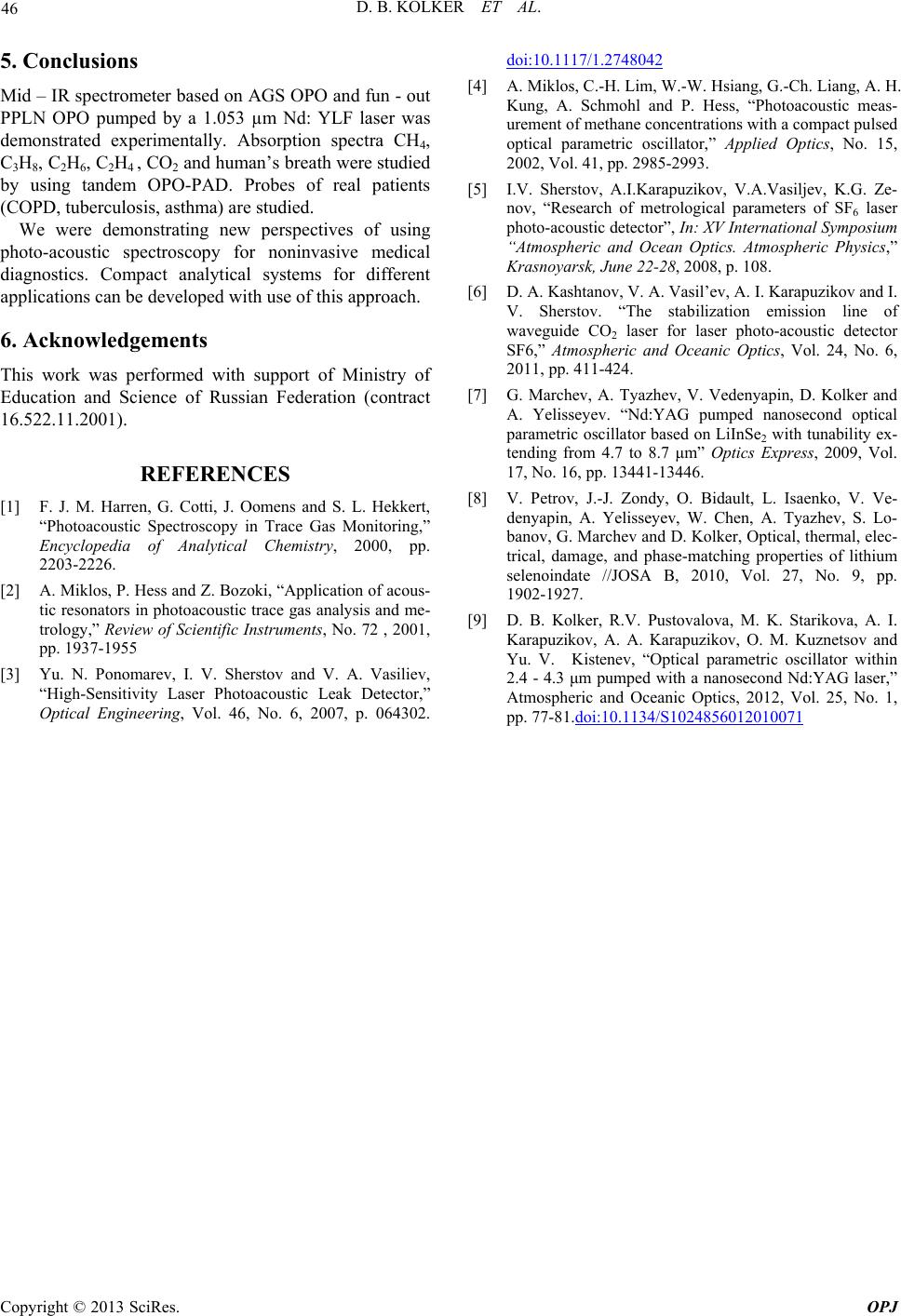
D. B. KOLKER ET AL.
Copyright © 2013 SciRes. OPJ
46
5. Conclusions
Mid – IR spectrometer based on AGS OPO and fun - out
PPLN OPO pumped by a 1.053 µm Nd: YLF laser was
demonstrated experimentally. Absorption spectra CH4,
C3H8, C2H6, C2H4 , CO2 and human’s breath were studied
by using tandem OPO-PAD. Probes of real patients
(COPD, tuberculosis, asthma) are studied.
We were demonstrating new perspectives of using
photo-acoustic spectroscopy for noninvasive medical
diagnostics. Compact analytical systems for different
applications can be developed with use of this approach.
6. Acknowledgements
This work was performed with support of Ministry of
Education and Science of Russian Federation (contract
16.522.11.2001).
REFERENCES
[1] F. J. M. Harren, G. Cotti, J. Oomens and S. L. Hekkert,
“Photoacoustic Spectroscopy in Trace Gas Monitoring,”
Encyclopedia of Analytical Chemistry, 2000, pp.
2203-2226.
[2] A. Miklos, P. Hess and Z. Bozoki, “Application of acous-
tic resonators in photoacoustic trace gas analysis and me-
trology,” Review of Scientific Instruments, No. 72 , 2001,
pp. 1937-1955
[3] Yu. N. Ponomarev, I. V. Sherstov and V. A. Vasiliev,
“High-Sensitivity Laser Photoacoustic Leak Detector,”
Optical Engineering, Vol. 46, No. 6, 2007, p. 064302.
doi:10.1117/1.2748042
[4] A. Miklos, C.-H. Lim, W.-W. Hsiang, G.-Ch. Liang, A. H.
Kung, A. Schmohl and P. Hess, “Photoacoustic meas-
urement of methane concentrations with a compact pulsed
optical parametric oscillator,” Applied Optics, No. 15,
2002, Vol. 41, pp. 2985-2993.
[5] I.V. Sherstov, A.I.Karapuzikov, V.A.Vasiljev, K.G. Ze-
nov, “Research of metrological parameters of SF6 laser
photo-acoustic detector”, In: XV International Symposium
“Atmospheric and Ocean Optics. Atmospheric Physics,”
Krasnoyarsk, June 22-28, 2008, p. 108.
[6] D. A. Kashtanov, V. A. Vasil’ev, A. I. Karapuzikov and I.
V. Sherstov. “The stabilization emission line of
waveguide CO2 laser for laser photo-acoustic detector
SF6,” Atmospheric and Oceanic Optics, Vol. 24, No. 6,
2011, pp. 411-424.
[7] G. Marchev, A. Tyazhev, V. Vedenyapin, D. Kolker and
А. Yelisseyev. “Nd:YAG pumped nanosecond optical
parametric oscillator based on LiInSe2 with tunability ex-
tending from 4.7 to 8.7 μm” Optics Express, 2009, Vol.
17, No. 16, pp. 13441-13446.
[8] V. Petrov, J.-J. Zondy, O. Bidault, L. Isaenko, V. Ve-
denyapin, А. Yelisseyev, W. Chen, A. Tyazhev, S. Lo-
banov, G. Marchev and D. Kolker, Optical, thermal, elec-
trical, damage, and phase-matching properties of lithium
selenoindate //JOSA B, 2010, Vol. 27, No. 9, pp.
1902-1927.
[9] D. B. Kolker, R.V. Pustovalova, M. K. Starikova, A. I.
Karapuzikov, A. A. Karapuzikov, O. M. Kuznetsov and
Yu. V. Kistenev, “Optical parametric oscillator within
2.4 - 4.3 μm pumped with a nanosecond Nd:YAG laser,”
Atmospheric and Oceanic Optics, 2012, Vol. 25, No. 1,
pp. 77-81.doi:10.1134/S1024856012010071